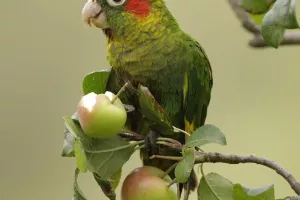The kingfisher is a medium-sized water bird with a large head and short neck, short rounded wings and a mostly short tail.
The beak is long and pointed, the peak of the beak is rounded and blunt, and the feet are very short.
It is mainly distributed in Eurasia and northern Africa, south of south-central Africa, south-central peninsula and southeast coastal areas of China.
The main species include common kingfisher, white-breasted emerald, blue emerald, spotted-headed kingfisher, three-toed kingfisher, etc.
The head, back, wings and tail feathers of the kingfisher are all blue, and the color of the back to the tail feathers is particularly vivid, a shiny bright blue with a metallic feel.
The beak (beak) is made up of two parts, the upper and lower, which can be called the upper and lower beak respectively.
The upper and lower beaks of the common kingfisher male are both black, while the female has an orange-red lower beak at its base.
Kingfishers eat about 60% of their body weight in fish each day.
They spend a lot of time crouched at the water's edge where they have a good view (e.g., on an outstretched branch, a protruding rosette, or a raised rock platform on the shore).
Once they see their prey, they rush out like an arrow, enter the water, grab the fish, exit the water, and fly back to their resting place almost instantaneously.
After entering the water, the kingfisher can maintain excellent eyesight, because his eyes enter the water and can quickly adjust to the contrast in perspective caused by the light in the water.
The kingfisher inhabits rivers, streams, lakes and irrigation canals with clear and slow-flowing water in thickets or sparse forests.
They are solitary and usually perch alone on branches or rocks near the water's edge, waiting for an opportunity to hunt, eating mainly small fish, crustaceans and a variety of aquatic insects and their larvae, and also pecking at small frogs and a few aquatic plants.
The kingfisher can use its large, sturdy beak to nest on the walls of earthen cliffs, and also nests in the tunnels of field dams, which, like woodpeckers, are generally unlined.
The reason why the kingfisher chooses such places is for sufficient food.
The kingfisher feeds on fish and has strong fishing skills and can chase fish in the water, so the kingfisher often appears in the waters of small rivers, streams, lakes and irrigation canals.
For the safety of the little kingfishers, no one will think that this is the nest of the kingfishers, so no one will capture it.
For the safety of the little kingfisher, the kingfisher will also make the nest very fishy.
The kingfisher will take the fish food into the hole and let the catcher pull out a big handful of fish scales, so that the very heavy smell will scare off the predators.
At the same time, in order to avoid the nest being discovered, the kingfisher's speed is like an arrow every time it enters and leaves the hole, so that the enemy is difficult to find its traces.


